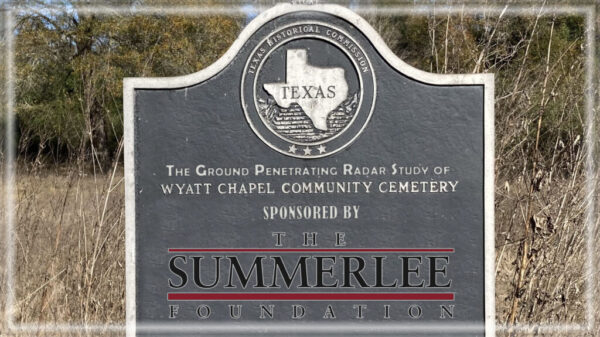Pedestrian Survey of Wyatt Chapel Community Cemetery
By Evelyn Todd
On October 21, we met with the Legacy Cultural Resources, Inc. team at the Wyatt Chapel Community Cemetery. We began the second phase of the cemetery study, where we conducted the Archaeological Pedestrian Survey.
The archaeologists led a team of student volunteers in an intensive pedestrian survey of the project area. We anticipated to cover 3-5 acres in size. Archaeologists worked with small groups of students, teaching them basic pedestrian survey techniques. After the pastor of the Wyatt Chapel Baptist Church prayed and blessed the team, the survey began.
As we marked and mapped out the gravesite, the archaeologists also worked with the students to record the Wyatt Chapel Community Cemetery as an archaeological site. This will provide it with a state-registered trinomial. Students worked with archaeologists to record the burial ground in the field on a TexSite form. We plan to submit and contact the Texas Archeological Research Laboratory (TARL) in Austin to obtain the trinomial.
The small groups walked the project area in transects spaced 30 meters (m) apart, looking for evidence of grave markers, grave tending artifacts, depressions, or other potential indicators of the presence of burials. After we marked these features with pin flags, the archaeologists taught participants how to map the burial site with a handheld Trimble GPS unit. Since we hoped to disturb the burial ground as little as possible, we did not collect any artifacts as part of the pedestrian survey. Instead, we photographed grave marker and grave tending artifacts in the field.
![Marking Graves Nesta Anderson and Melanie Nichols explaining to students and alumni the process of recording unmarked burials in a cemetery [Photo © T. DeWayne Moore, 2023]](https://pvpantherproject.com/wp-content/uploads/2023/12/thumbnail_IMG_2655-1024x768-422x316.jpg)
There were a few surprising finds during the survey. We were shocked to realize how large the gravesite was compared to the estimations. Students marked off graves along most of the fence lines. We also found grave tending materials around a tree closer to the front of the walking path than expected.
We also learned a new technique for determining burial spots. Using the pin flags, we were told to push them into the ground in areas we believed marked a grave. If the pin flag was restricted from going too far into the ground, that was used as a point of interest to where someone may have been buried. Using this method, we found areas in the cemetery where there appeared to be parallel rows of burials. This method also helped us find possible burial sites near a group of 3 trees. At these trees, students also found a large cluster of grave tending materials and grave borders, which tends to signify a family was buried there.
Based on reports in the early 2000s, this gravesite was unknowingly being used as a dumping ground. Once this was found out, the powers that be had the trash moved. However, the trash was bulldozed further back and to the right onto that land and fenced in. As we worked on the Pedestrian Survey, we could get a whiff of the trash behind the fence as we got closer to the fence or if the wind blew. The pastor of Wyatt Chapel Baptist Church and others from the community believe that cemetery extends to where the trash now sits.
Towards the end of the survey, Nesta Anderson and Melanie Nichols–of Legacy Cultural Resources, Inc–went over the fence and performed an examination of the trash pile. We plan to report our findings to the Texas Historical Commission, which will offer guidance on the removal of the trash. In doing this, it will help us to get written authorization from the THC to remove the garbage and survey that land as well.
Overall, the second phase of the cemetery study was successful, and the team plans to move on to the third phase in the upcoming spring semester.
The Digital PV Panther Project looks forward to receiving feedback from both Legacy Cultural Resources and the Texas Historical Commission in 2024!
Our mission at the Digital PV Panther Project is to eliminate historical silences through digital storytelling and prevent the erasure of African American history through historic preservation at PVAMU.
![Cemetery Study Team PVAMU students and alumni as well as members of the Waller County Historical Commission and the Prairie View Heritage Committee prepare to begin the survey on October 21, 2023 [Photo © T. DeWayne Moore, 2023]](https://pvpantherproject.com/wp-content/uploads/2023/12/thumbnail_IMG_2629-1024x768-650x487.jpg)
![A community volunteer searches for unmarked graves A community volunteer searches for unmarked graves [Photo © Evelyn Todd, 2023]](https://pvpantherproject.com/wp-content/uploads/2023/12/IMG_3682-768x1024-360x480.jpg)
![Nesta Anderson documenting unmarked graves with PVAMU students Nesta Anderson documenting unmarked graves with PVAMU students [Photo © T. DeWayne Moore, 2023]](https://pvpantherproject.com/wp-content/uploads/2023/12/thumbnail_IMG_2674-1024x768-360x270.jpg)
![Unmarked Graves Rows of possible unmarked graves marked with flags [Photo © Evelyn Todd, 2023]](https://pvpantherproject.com/wp-content/uploads/2023/12/IMG_3680-768x1024-360x480.jpg)
![Lindsay Boknight Lindsay Boknight looking for unmarked graves during the pedestrian survey on October 21, 2023 [Photo © T. DeWayne Moore, 2023]](https://pvpantherproject.com/wp-content/uploads/2023/12/thumbnail_IMG_2645-1024x768-360x270.jpg)

![thumbnail_IMG_2660 The headstone of Elsie Bailey after initial cleaning with D2 biological solution [Photo © T. DeWayne Moore, 2023]](https://pvpantherproject.com/wp-content/uploads/2023/12/thumbnail_IMG_2660-768x1024-640x853.jpg)
![thumbnail_IMG_2659 The broken headstone of Albert "Pap" Colling [Photo © T. DeWayne Moore, 2023]](https://pvpantherproject.com/wp-content/uploads/2023/12/thumbnail_IMG_2659-768x1024-640x853.jpg)
![Luther Felder headstone The military headstone of Luther B. Felder over a year after cleaning with D2 biological solution [Photo © T. DeWayne Moore, 2023]](https://pvpantherproject.com/wp-content/uploads/2023/12/thumbnail_IMG_2658-768x1024-640x853.jpg)
![thumbnail_IMG_2657 The headstone of Milo Wilson Jr. after the initial cleaning with D2 biological solution [Photo © T. DeWayne Moore, 2023]](https://pvpantherproject.com/wp-content/uploads/2023/12/thumbnail_IMG_2657-768x1024-640x853.jpg)
![thumbnail_IMG_2679 Melanie Nichols, Gregory Newton, Nesta Anderson, and Sabrina Francis record the last of the unmarked burials in the cemetery [Photo © T. DeWayne Moore, 2023]](https://pvpantherproject.com/wp-content/uploads/2023/12/thumbnail_IMG_2679.jpg)
![thumbnail_IMG_2654 Gregory Newton leans over to examine one of the many field stones uncovered in the cemetery [Photo © T. DeWayne Moore, 2023]](https://pvpantherproject.com/wp-content/uploads/2023/12/thumbnail_IMG_2654.jpg)